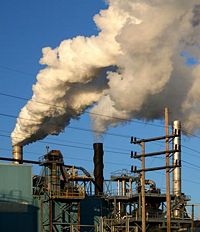AERMOD air pollution dispersion model
The AERMOD air pollution dispersion model is an integrated system for modeling the dispersion of air pollutants. It includes three modules:[1][2][3]
- A steady-state dispersion model designed for short-range (up to 50 kilometers) dispersion of air pollutant emissions from stationary industrial sources.
- A meteorological data preprocessor (AERMET) that accepts surface meteorological data, upper air soundings, and optionally, data from on-site instrument towers. It then calculates atmospheric parameters needed by the dispersion model, such as atmospheric turbulence characteristics, mixing heights, friction velocity, Monin-Obukov length and surface heat flux.
- A terrain preprocessor (AERMAP) whose main purpose is to provide a physical relationship between terrain features and the behavior of air pollution plumes. It generates location and height data for each receptor location. It also provides information that allows the dispersion model to simulate the effects of air flowing over hills or splitting to flow around hills.
AERMOD also includes PRIME (Plume Rise Model Enhancements)[4] which is an algorithm for modeling the effects of downwash created by the pollution plume flowing over nearby buildings.
History of the development of AERMOD
AERMOD was developed by the AERMIC (AMS/EPA Regulatory Model Improvement Committee), a collaborative working group of scientists from the AMS and the EPA.[1] The AERMIC was initially formed in 1991.
The AERMIC developed AERMOD in seven steps:
- Initial model formulation
- Developmental evaluation
- Internal peer review and beta testing
- Revised model formulation
- Performance evaluation and sensitivity testing
- External peer review
- Submission to the EPA for consideration as a regulatory model.
On April 21st of 2000, the EPA proposed that AERMOD be adopted as the EPA's preferred regulatory model for both simple and complex terrain.[5] On November 9th of 2005, AERMOD was adopted by the EPA and promulgated as their preferred regulatory model, effective as of December 9th of 2005. [6] The entire developmental and adoption process took 14 years (from 1991 to 2005).
Features and capabilities of AERMOD
Some of the primary features and capabilities of AERMOD are:[2][7][8]
- Source types: Multiple point, area and volume sources
- Source releases: Surface, near surface and elevated emission sources
- Source locations: Urban or rural locations. Urban effects are scaled by population.
- Plume types: Continuous, buoyant plumes
- Plume deposition: Dry or wet deposition of particulates and/or gases
- Plume dispersion treatment: Gaussian model treatment in horizontal and in vertical for stable atmospheres. Non-Gaussian treatment in vertical for unstable atmospheres
- Terrain types: Simple or complex terrain
- Building effects: Handled by PRIME downwash algorithms
- Meteorology data height levels: Accepts meteorology data from multiple heights
- Meteorological data profiles: Vertical profiles of wind, turbulence and temperature are created
References
- ↑ 1.0 1.1 AERMOD:Description of Model Formulation
- ↑ 2.0 2.1 Prater, E.T. and Midgley, C., A new air dispersion modeling system is helping create more accurate industrial source models, Environmental Protection, Vol. 17, No. 3, Stevens Publishing
- ↑ Brode, R.W., AERMOD Technical Forum, EPA R/S/L Modelers Workshop, San Diego, California, April 16, 2006
- ↑ Development and Evaluation of the PRIME Plume Rise and Building Downwash Model
- ↑ Federal Register: April 21, 2000 (Volume 65, Number 78) Proposed Rule
- ↑ Federal Register: November 9, 2006 (Volume 70, Number 216) Final Rule
- ↑ AERMOD:Latest Features and Evaluation Results (EPA-454/R-03-003)
- ↑ McVehil-Monnet Associates Air Quality Newsletter
Further reading
For those who would like to learn more about this topic, it is suggested that either one of the following books be read:
- Turner, D.B. (1994). Workbook of Atmospheric Dispersion Estimates, 2nd Edition. CRC Press. ISBN 1-56670-023-X. www.crcpress.com
- Schnelle, Jr., Karl B. and Dey, Partha R. (2000). Atmospheric Dispersion Modeling Compliance Guide. McGraw-Hill. ISBN 0-07-058059-6.
- Beychok, Milton R. (2005). Fundamentals of Stack Gas Dispersion, 4th Edition. author-published. ISBN 0-9644588-0-2.
